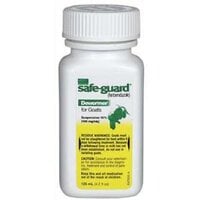Can you advise more on the Safeguard in the water and egg withdrawal theory? I thought I had to do the withdrawal if I added 3ml per gallon of drinking water for 5 days.Valbazen would require withdrawal if that sort of thing worries you, so would Safeguard if you use *any* of the doses mentioned in your thread.
However, if you were to use a very small dose of Safeguard 5 days in a row you would not need to toss the eggs. Safeguard in small doses for 5 days in a row is approved for use in laying hens.
View attachment 1949116
View attachment 1949117
The approved dose is 1 mg/kg for five days and that works out to ~0.023 ml per five pounds for five days.
If you don't want to hassle treating each bird you could try feeding it to them in a mash. If I were going to do that this is how I would do it.
Note: If one has capillary worms in their flock a higher dose is needed and that higher dose will require egg withdrawal.
- Count number of birds to be treated.
- Estimate the weight of each bird.
- Calculate flock weight. For example, if you have 10 leghorns at ~4 pounds each and 10 RIR's at 6 pounds each, that's 100 pounds of birds.
- Calculate the amount of Safeguard needed. In my example it's 100 (weight of flock) divide by 2.2 (this converts to kg) times 1 (the dose needed) divide by 100 (the amount of medication in one ml) 100 ÷ 2.2 x 1 ÷ 100 = 0.45 ml
- Set aside the amount of pellets or crumbles they will eat in a day in a big container.
- Mix the 0.45 ml of Safeguard in some amount of water, two cups maybe? Add the water/Safeguard mixture to the crumbles, stir a little, then add more water until the feed is nice and wet. Mix *very* well.
- Repeat for five days and this should treat large roundworms and cecal worms, but will not treat capillary worms and this should not be done if your flock has capillary worms.
Please, always check my math, 'cause I do make lots of mistakes.

http://www.dosagehelp.com/dosage_by_weight.html
So far it has worked for me but one chicken still has tape worms in her poop after 5 days. So frustrating.




